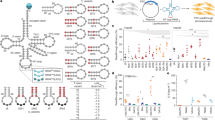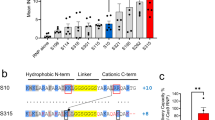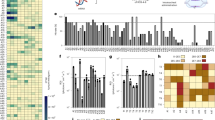Abstract
Developing safe and efficient non-viral delivery systems remains a major challenge for in vivo applications of gene therapy, especially in cystic fibrosis. Unlike conventional cationic polymers or lipids, the emerging poloxamine-based copolymers display promising in vivo gene delivery capabilities. However, poloxamines are invalid for in vitro applications and their in vivo transfection efficiency is still low compared with viral vectors. Here, we show that peptides developed by modular design approaches can spontaneously form compact and monodisperse nanoparticles with poloxamines and nucleic acids via self-assembly. Both messenger RNA and plasmid DNA expression mediated by peptide-poloxamine nanoparticles are greatly boosted in vitro and in the lungs of cystic fibrosis mice with negligible toxicity. Peptide–poloxamine nanoparticles containing integrating vectors enable successful in vitro and in vivo long-term restoration of cystic fibrosis transmembrane conductance regulator deficiency with a safe integration profile. Our dataset provides a new framework for designing non-viral gene delivery systems qualified for in vivo genetic modifications.
This is a preview of subscription content, access via your institution
Access options
Access Nature and 54 other Nature Portfolio journals
Get Nature+, our best-value online-access subscription
$29.99 / 30 days
cancel any time
Subscribe to this journal
Receive 12 print issues and online access
$259.00 per year
only $21.58 per issue
Buy this article
- Purchase on Springer Link
- Instant access to full article PDF
Prices may be subject to local taxes which are calculated during checkout






Similar content being viewed by others
Data availability
All of the primary data that support the findings of this study are available from the corresponding author on request.
References
Stoltz, D. A., Meyerholz, D. K. & Welsh, M. J. Origins of cystic fibrosis lung disease. N. Engl. J. Med. 372, 351–362 (2015).
Joseph, P. M. et al. Aerosol and lobar administration of a recombinant adenovirus to individuals with cystic fibrosis. I. Methods, safety, and clinical implications. Hum. Gene Ther. 12, 1369–1382 (2001).
Moss, R. B. et al. Repeated aerosolized AAV-CFTR for treatment of cystic fibrosis: a randomized placebo-controlled phase 2B trial. Hum. Gene Ther. 18, 726–732 (2007).
Konstan, M. W. et al. Compacted DNA nanoparticles administered to the nasal mucosa of cystic fibrosis subjects are safe and demonstrate partial to complete cystic fibrosis transmembrane regulator reconstitution. Hum. Gene Ther. 15, 1255–1269 (2004).
Elborn, J. S. Cystic fibrosis. Lancet 388, 2519–2531 (2016).
Yin, H. et al. Non-viral vectors for gene-based therapy. Nat. Rev. Genet. 15, 541–555 (2014).
Alton, E. W. F. W. et al. Repeated nebulisation of non-viral CFTR gene therapy in patients with cystic fibrosis: a randomised, double-blind, placebo-controlled, phase 2B trial. Lancet Respir. Med. 3, 684–691 (2015).
Cox, D. B. T., Platt, R. J. & Zhang, F. Therapeutic genome editing: prospects and challenges. Nat. Med. 21, 121–131 (2015).
Richard-Fiardo, P. et al. Evaluation of tetrafunctional block copolymers as synthetic vectors for lung gene transfer. Biomaterials 45, 10–17 (2015).
Dahlman, J. E. et al. In vivo endothelial siRNA delivery using polymeric nanoparticles with low molecular weight. Nat. Nanotechnol. 9, 648–655 (2014).
Zuris, J. A. et al. Cationic lipid-mediated delivery of proteins enables efficient protein-based genome editing in vitro and in vivo. Nat. Biotechnol. 33, 73–80 (2015).
Alvarez-Lorenzo, C., Rey-Rico, A., Sosnik, A., Taboada, P. & Concheiro, A. Poloxamine-based nanomaterials for drug delivery. Front. Biosci. (Elite Ed.) 2, 424–440 (2010).
Pitard, B. et al. Negatively charged self-assembling DNA/poloxamine nanospheres for in vivo gene transfer. Nucleic Acids Res. 32, e159 (2004).
Dowdy, S. F. Overcoming cellular barriers for RNA therapeutics. Nat. Biotechnol. 35, 222–229 (2017).
Blanco, E., Shen, H. & Ferrari, M. Principles of nanoparticle design for overcoming biological barriers to drug delivery. Nat. Biotechnol. 33, 941–951 (2015).
Stewart, M. P. et al. Break and enter: in vitro and ex vivo strategies for intracellular delivery. Nature 538, 183–192 (2016).
Zeng, J., Wang, X. & Wang, S. Self-assembled ternary complexes of plasmid DNA, low molecular weight polyethylenimine and targeting peptide for nonviral gene delivery into neurons. Biomaterials 28, 1443–1451 (2007).
Tagalakis, A. D., He, L., Saraiva, L., Gustafsson, K. T. & Hart, S. L. Receptor-targeted liposome–peptide nanocomplexes for siRNA delivery. Biomaterials 32, 6302–6315 (2011).
Yin, H., Kauffman, K. J. & Anderson, D. G. Delivery technologies for genome editing. Nat. Rev. Drug Discov. 16, 387–399 (2017).
McNeer, N. A. et al. Nanoparticles that deliver triplex-forming peptide nucleic acid molecules correct F508del CFTR in airway epithelium. Nat. Commun. 6, 6952 (2015).
Kreda, S. M. et al. Characterization of wild-type and F508 cystic fibrosis transmembrane regulator in human respiratory epithelia. Mol. Biol. Cell 16, 2154–2167 (2005).
Writer, M. J. et al. Targeted gene delivery to human airway epithelial cells with synthetic vectors incorporating novel targeting peptides selected by phage display. J. Drug Target. 12, 185–193 (2004).
Hackett, P. B. Integrating DNA vectors for gene therapy. Mol. Ther. 15, 10–12 (2007).
Charizopoulou, N. et al. Spontaneous rescue from cystic fibrosis in a mouse model. BMC Genet. 7, 18 (2006).
Cheng, S. H. et al. Defective intracellular transport and processing of CFTR is the molecular basis of most cystic fibrosis. Cell 63, 827–834 (1990).
Dekkers, J. F. et al. A functional CFTR assay using primary cystic fibrosis intestinal organoids. Nat. Med. 19, 939–945 (2013).
Alton, E. W. F. W. et al. Preparation for a first-in-man lentivirus trial in patients with cystic fibrosis. Thorax 72, 137–147 (2017).
Nakai, H. et al. Large-scale molecular characterization of adeno-associated virus vector integration in mouse liver. J. Virol. 79, 3606–3614 (2005).
Tipanee, J., Chai, Y. C., VandenDriessche, T. & Chuah, M. K. Preclinical and clinical advances in transposon-based gene therapy. Biosci. Rep. 37, BSR20160614 (2017).
Kebriaei, P., Izsvák, Z., Narayanavari, S. A., Singh, H. & Ivics, Z. Gene therapy with the S leeping Beauty transposon system. Trends Genet. 33, 852–870 (2017).
Voigt, K. et al. Retargeting Sleeping Beauty transposon insertions by engineered zinc finger DNA-binding domains. Mol. Ther. 20, 1852–1862 (2012).
Kovač, A. & Ivics, Z. Specifically integrating vectors for targeted gene delivery: progress and prospects. Cell Gene Ther. Insights 3, 103–123 (2017).
Lee, C. M., Flynn, R., Hollywood, J. A., Scallan, M. F. & Harrison, P. T. Correction of the ΔF508 mutation in the cystic fibrosis transmembrane conductance regulator gene by zinc-finger nuclease homology-directed repair. Biores. Open Access 1, 99–108 (2012).
Schwank, G. et al. Functional repair of CFTR by CRISPR/Cas9 in intestinal stem cell organoids of cystic fibrosis patients. Cell Stem Cell 13, 653–658 (2013).
Suk, J. S. et al. The penetration of fresh undiluted sputum expectorated by cystic fibrosis patients by non-adhesive polymer nanoparticles. Biomaterials 30, 2591–2597 (2009).
Duncan, G. A., Jung, J., Hanes, J. & Suk, J. S. The mucus barrier to inhaled gene therapy. Mol. Ther. 24, 2043–2053 (2016).
Huckaby, J. T. & Lai, S. K. PEGylation for enhancing nanoparticle diffusion in mucus. Adv. Drug Deliv. Rev. 124, 125–139 (2018).
Kim, N., Duncan, G. A., Hanes, J. & Suk, J. S. Barriers to inhaled gene therapy of obstructive lung diseases: a review. J. Control. Release 240, 465–488 (2016).
Di Gioia, S. et al. Nanocomplexes for gene therapy of respiratory diseases: targeting and overcoming the mucus barrier. Pulm. Pharmacol. Ther. 34, 8–24 (2015).
Nafee, N. et al. Antibiotic-free nanotherapeutics: ultra-small, mucus-penetrating solid lipid nanoparticles enhance the pulmonary delivery and anti-virulence efficacy of novel quorum sensing inhibitors. J. Control. Release 192, 131–140 (2014).
Yang, M. et al. Biodegradable nanoparticles composed entirely of safe materials that rapidly penetrate human mucus. Angew. Chem. Int. Ed. Engl. 50, 2597–2600 (2011).
Suk, J. S. et al. Lung gene therapy with highly compacted DNA nanoparticles that overcome the mucus barrier. J. Control. Release 178, 8–17 (2014).
Mastorakos, P. et al. Highly compacted biodegradable DNA nanoparticles capable of overcoming the mucus barrier for inhaled lung gene therapy. Proc. Natl Acad. Sci. USA 112, 8720–8725 (2015).
Rogers, C. S. et al. Disruption of the CFTR gene produces a model of cystic fibrosis in newborn pigs. Science 321, 1837–1841 (2008).
Rosen, B. H. et al. Animal and model systems for studying cystic fibrosis. J. Cyst. Fibros. 17, S28–S34 (2018).
Cooney, A. L., Singh, B. K. & Sinn, P. L. Hybrid nonviral/viral vector systems for improved piggyBac DNA transposon in vivo delivery. Mol. Ther. 23, 667–674 (2015).
Bello-Roufaï, M., Lambert, O. & Pitard, B. Relationships between the physicochemical properties of an amphiphilic triblock copolymers/DNA complexes and their intramuscular transfection efficiency. Nucleic Acids Res. 35, 728–739 (2007).
Roques, C., Bouchemal, K., Ponchel, G., Fromes, Y. & Fattal, E. Parameters affecting organization and transfection efficiency of amphiphilic copolymers/DNA carriers. J. Control. Release 138, 71–77 (2009).
Johler, S. M., Rejman, J., Guan, S. & Rosenecker, J. Nebulisation of IVT mRNA complexes for intrapulmonary administration. PLoS ONE 10, e0137504 (2015).
Kormann, M. S. D. et al. Expression of therapeutic proteins after delivery of chemically modified mRNA in mice. Nat. Biotechnol. 29, 154–157 (2011).
Acknowledgements
The authors are grateful to G. Vassaux (University of Nice Sophia Antipolis) and B. Pitard (University of Nantes) for introducing and providing poloxamine 704, and to S. Hyde (University of Oxford) for providing a CpG-depleted CFTR expression cassette. Special thanks go to S. L. Hart (University College London) for developing targeting elements showing high affinity to human airway epithelial cells. We also thank J. Geiger (Ethris) for providing SNIM-mRNA, M. K. Aneja (Ethris) for careful proofreading of the manuscript, Y. Liu, J. Rejman and J. Zhang (Ludwig Maximilian University of Munich) for technical support, and J. Tang (University of Queensland) for assistance with the Prism software. This work was supported by the Bundesministerium für Bildung und Forschung under project number 01GM1106A.
Author information
Authors and Affiliations
Contributions
S. Guan and J.R. conceived and developed the delivery system. C.R. and Z.I. generated the SB transposon system. A.M., G.H., S.H., W.G. and S. Guan designed and performed the animal experiments. S. Guan, L.Z. and A.S. characterized the nanoparticles. S. Guan, A.S. and S.M.J. performed the in vitro experiments. A.M., S.H., P.B., S. Glage, S.L., F.S. and C.M. performed the in vivo endpoint studies. Y.K. was responsible for the bioinformatics and integration sites analysis. B.T., C.R., Z.I. and J.R. designed and supervised the research. S. Guan and J.R. wrote the manuscript with comments from all authors.
Corresponding author
Ethics declarations
Competing interests
S. Guan and J.R. have filed patent applications on the subject matter related to this study. C.R. is a scientific co-founder and chief executive officer of the biotechnology company Ethris, which focuses on the development of mRNA therapies. G.H. is an employee of Ethris. Y.K. is an employee of Eurofins GATC Biotech. The other authors declare no competing interests.
Additional information
Publisher’s note: Springer Nature remains neutral with regard to jurisdictional claims in published maps and institutional affiliations.
Supplementary information
Supplementary Information
Supplementary Figure 1–28, Supplementary Tables 1,2, Supplementary Methods, Supplementary Results, Supplementary Notes, Supplementary References
Rights and permissions
About this article
Cite this article
Guan, S., Munder, A., Hedtfeld, S. et al. Self-assembled peptide–poloxamine nanoparticles enable in vitro and in vivo genome restoration for cystic fibrosis. Nat. Nanotechnol. 14, 287–297 (2019). https://doi.org/10.1038/s41565-018-0358-x
Received:
Accepted:
Published:
Issue Date:
DOI: https://doi.org/10.1038/s41565-018-0358-x
This article is cited by
-
tRNA therapeutics for genetic diseases
Nature Reviews Drug Discovery (2024)
-
Self-assembled peptide/polymer hybrid nanoplatform for cancer immunostimulating therapies
Drug Delivery and Translational Research (2024)
-
Engineering precision nanoparticles for drug delivery
Nature Reviews Drug Discovery (2021)
-
Optimization of lipid nanoparticles for the delivery of nebulized therapeutic mRNA to the lungs
Nature Biomedical Engineering (2021)



